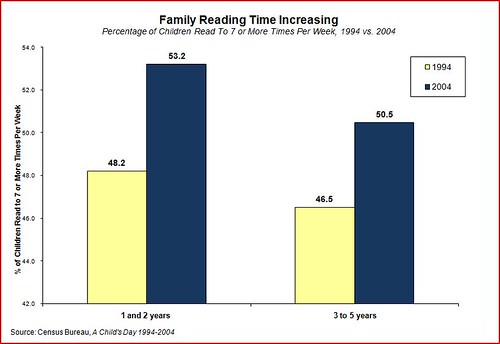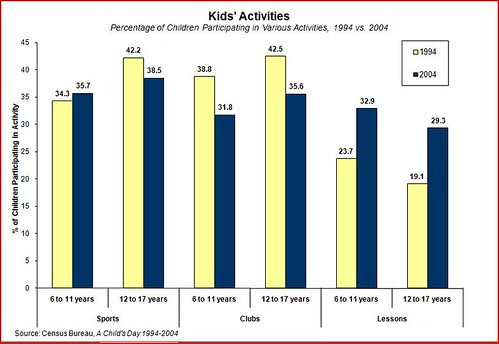The kids are alright. Not only is that the title of one of my favorite songs by The Who, but it also happens to be the theme of much of my public policy research. Specifically, I spend a great deal of time analyzing social trends and media usage in an attempt to show that, contrary to what many media critics claim, the whole world is not going to hell. I’ve touched on these themes before in essays such as “Why hasn’t violent media turned us into a nation of killers?” and my PFF paper about “Fact and Fiction in the Debate Over Video Game Regulation.”
In this research, I try to bring some hard evidence to bear on the question of whether there is any correlation between exposure to violent media and real world acts of violence / aggression. And I also try to show that parents are actually far more involved in raising their kids, and instilling good values in them, than critics care to admit. In essence, parents are parenting! I illustrate that in my ongoing book, Parental Controls & Online Child Protection: A Survey of Tools & Methods.” I keep that publication up to date with as much info as I can find on the subject and plan on issuing new versions of the report every few months. (Version 3.0 is due out early next year.)
And now I have some more great stats and charts to include in my report thanks to the release of a big batch of new Census Bureau data on child-parent interaction. The Census Bureau data, which is available here, is part of a report entitled A Child’s Day. The last report was conducted in 1994, and the most recent one in 2004, but the data for 2004 was just recently released.
The results are very encouraging and generally show that “Parents are taking a more active role in the lives of their children than they did 10 years ago,” according to the Census Bureau. For example, as Exhibit 1 above shows, parents are crafting more TV rules for the kids today than they were in the past.
I devoted an entire chapter of my parental controls book (Chapter 2) to “household media rules” like those described in the Census Bureau survey. In many ways, these household media rules represent the most important steps that most parents can take in dealing with potentially objectionable content or teaching their children how to be sensible, savvy media consumers. Moreover, to the extent that many households never take advantage of the many technical parental control tools (or ratings), it is likely because they rely instead on the informal household media rules.
I group those household media rules into three general categories: (1) “where” rules; (2) “when and how much” rules; and, (3) “under what conditions” rules. (I discuss these rules in more detail in this previous post). The Census Bureau also does this in its report and those numbers cited in Exhibit 1 above are for parents who use 3 types of TV rules: rules for the type of programming allowed, the number of hours watched, and the time of day viewed. Again, parents are setting more of those rules than they did in the past.
Those results are similar to the findings of recent polls by the Kaiser Family Foundation and the Pew Internet & American Life Project, two of the leading organizations studying online trends. A 2003 Kaiser survey found that “Almost all parents say they have some type of rules about their children’s use of media.” More recent Kaiser surveys have bolstered that finding.
For example, a 2006 Kaiser survey of families with infants and preschoolers revealed that 85 percent of those parents who let their children watch TV at that age have rules about what their child can and cannot watch. Of those parents, 63 percent say they always enforce those rules. About the same percentage of parents said they had similar rules for video game and computer usage. Likewise, a June 2007 Kaiser poll revealed that:
* 65 percent of parents say they closely monitor their children’s media use;
* 73 percent of parents say they know a lot about what their kids are doing online;
* 87 percent of parents check their children’s instant messaging “buddy lists;”
* 82 percent of parents review their children’s social networking sites; and,
* 76 percent of parents look to see what websites their children have visited.
Pew Internet & American Life Project surveys show similar trends. A 2006 Pew survey of media usage by teenagers revealed that 74 percent of homes with teenagers have their computers in an “open family area.” That result was consistent with Pew surveys taken in 2004 and 2000. The 2006 Pew survey also found that 58 percent of parents limit the amount of time their children can spend watching television; 59 percent limit how much time their kids can play video games; and 69 percent limit how much time their children can spend online.
Thus, these Kaiser and Pew survey results support the Census Bureau findings about parents getting more serious about setting household media rules.
And there’s more good news in the Census report. The percentage of parents reading books to their children seven or more times per week has risen from a decade ago. Exhibit 2 highlights these findings. That’s great news because many educators and development experts believe that reading to young children is incredibly important for their educational and psychological development.
For extracurricular activities, the results are somewhat mixed, but still generally encouraging. As Exhibit 3 illustrates, the amount of time that young children are spending playing sports increased from 1994 to 2004, but the numbers fell a bit for 12 to 17 year olds. The amount of time both sets of children spent taking lessons of various types rose considerably over that period. But the amount of time they spent with clubs fell. It could be that social networking and other online activities is substituting for some of those old “clubs,” so I’m not too worried about those results yet.
The world isn’t perfect, of course. If it was, 100% of parents would be reading to their kids multiple times each day, setting sensible household ground rules for media consumption, and getting their kids involved in more activities. But these new Census numbers are encouraging and have generally been improving over time. With more education and awareness-building efforts about the importance of parental involvement with children, these results will hopefully improve even more in coming years. Let’s give parents (and kids!) a little credit for once.




 The Technology Liberation Front is the tech policy blog dedicated to keeping politicians' hands off the 'net and everything else related to technology.
The Technology Liberation Front is the tech policy blog dedicated to keeping politicians' hands off the 'net and everything else related to technology.